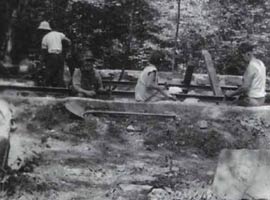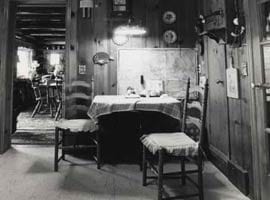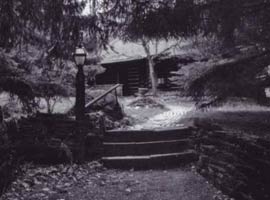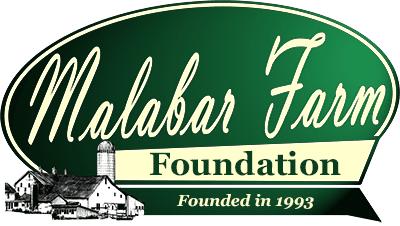Article Contribution
The following is a history of Pugh Cabins, located in the sugar bush area at Malabar Farm State Park, as remembered by Betty (Pugh) Berry, Daughter of Jim (James) Pugh. The history and imagery were compiled by Dr. Robert Berry [Dr. Robert D. Berry, Chiropractic Physician Chiropractic Health Center], a descendant of James Pugh, in addition to his financial contributions for interpretive signs and the restoration of the train bell collection mentioned in this article.

James Pugh (1892-1974) was originally from Gretna, Virginia. He served in France with the US Army during WW1 and returned to marry Georgia Mowery (1900-1989) of Newville, Ohio. The Pugh’s moved to Mansfield where Jim worked as the line superintendent for Ohio Public Service which became Ohio Edison.
Jim Pugh built the upper cabin as a year-round weekend retreat in 1938. In 1948, their son Bob married Marnie Wadsworth of Mansfield and their daughter Betty married Duane Berry of Lucas. In that same year Jim added the kitchen, two bedrooms, bathroom, basement and enclosed side porch to the original cabin. The side porch included a built-in-bar and a fireplace. It was at this time the cabin became the permanent home of Jim and Georgia Pugh.
The cabin logs were decommissioned pine electric poles. Jim was given these poles from Ohio Public Service and proceeded to shave off the outside weathered wood with the aid of a handheld draw knife. The poles were then coated with varnish to preserve them. Jim, his son Bob Pugh and friends used ropes, cables and pulleys strung from trees to set the logs in place.

The sandstone foundation stones were removed from basements of homes in Newville (corner of St. Rt. 95 and St. Rt. 603). The town of Newville was vacated due to the possibility of flooding from the newly built Pleasant Hill Dam. Jim had permission from Pleasant Hill officials to remove and use these stones. In 1936 Pleasant Hill Lake was completed but ironically Newville didn’t flood. The stones were also used for walls, sidewalks, entrance pillars, flower bed walls, patio floors and both fireplaces. The brick sidewalks around the cabin were made from old street pavers from south Main Street in Mansfield.
Jim built a spring fed pond below the cabin complete with a wooden dock and white sand beach. A sandstone wall outlined the beach area. Since there was no electricity in the cabin, Jim built a water wheel and used the pond overflow water to run a generator that made enough electricity to run a couple of lights in the cabin. Later more electricity was needed, so Jim purchased an old 8-cylinder Buick engine, mounted it on a frame and used it to run a generator that provided plenty of electric power.

A spring above the cabin provided water via gravity to the sink and toilet. When you sat on the toilet it would fill from the storage tank in the sleeping loft.
The bannister on the staircase to the loft was received as payment for electrical work completed for the Jones sisters of Oak Hill Cottage in Mansfield. The sisters also gave him a similar wrought iron railing which he used in the lower cabin.
Jim also built an outdoor picnic shelter just above the cabin. This was initially an open-air covered shelter that had a sandstone fireplace in the western end that included a rotisserie spit and exhaust hood. The site where he built the picnic shelter had a huge sandstone boulder on it.
Jim was going to blow the boulder up with dynamite but as he dug under the stone to place the dynamite, he found bones that he had checked out by a doctor friend who confirmed they were human remains. Because of the burial method it was thought the remains must be that of an Indian. Instead of blasting the stone, he covered the remains back up then built the picnic shelter around the stone.
Jim eventually enclosed the sides of the picnic shelter. The huge sandstone rock became the eastern end of the picnic shelter and Jim eventually mounted his collection of steam locomotive bronze and brass bells, steam engine emblems, steam gauges and a brass locomotive steam whistle on and around the huge stone.
Mr. Pugh installed wall mounted; battery operated wooden crank telephones, one in the picnic shelter and one in the kitchen of the cabin. One could ring the cabin from the picnic shelter and vice versa. He put windows in the picnic shelter that he bought from the city of Mansfield. These windows were made from isinglass windows from retired street cars used in Mansfield. They let light thru but you could not see clearly thru them.

Mr. Pugh had a brass steam locomotive whistle mounted on the roof of the picnic shelter that was connected to a steam engine. Not too far away from the cabin was the natural gas pumping station (now Weaver Station, part of Columbia Gas) in Pleasant Valley, next to the Pleasant Valley Church and Pleasant Valley Cemetery. The pumping station used steam engines to pump natural gas into the ground for storage and when the pumping station would blow its steam whistle at quitting time, Jim would often blow his whistle to ‘answer’ theirs.
The solid bronze chandeliers in the main part of the cabin were purchased from the Farmers Bank which sat at the corner of Walnut St. and Park Avenue West in Mansfield. The Farmers Bank sold the chandeliers to Jim when they remodeled the bank. The chandelier in the main room of the cabin was very large and was surrounded by rows of accent light bulbs. A smaller version of that chandelier was mounted over the dining room table below the upper loft.
Jim and Georgia were good friends of Louis and Mary Bromfield. Louis Bromfield was a Pulitzer Prize winning novelist who was born in Mansfield. Louis Bromfield loved Pleasant Valley and bought a farm from the Haring family which he expanded and developed into Malabar Farm. Malabar Farm was named after the Malabar Coast, the southwest coastline of mainland India. Jim and Louis Bromfield held many social parties together, either at the cabin or at The Big House at Malabar Farm. Louis Bromfield mentions Jim Pugh in his book Pleasant Valley, copyrighted in 1943 on pages 253-254.

In 1948 Louis Bromfield hosted a fundraiser for U. S. Senator Robert Alfonso Taft, the son of the 27th President of the United States, William Howard Taft. Senator Robert A. Taft was running in the Republican primary for President of the United States. Senator and Mrs. Robert Taft, Mr. And Mrs. Louis Bromfield and a few other special guests had dinner, prepared by Jim and Georgia, at the cabin after the fundraiser. Senator Robert Taft tried three times unsuccessfully to become the Republican candidate for the Presidency (1940/1944/1948). Thousands of people attended the fundraiser at Malabar Farm in 1948. Senator Robert Taft died in 1953. Senator Robert A. Taft was the grandfather of Ohio’s 67th governor, Governor Robert ‘Bob’ Alfonso Taft, II.

In 1956, Mr. Pugh built a second cabin below the first cabin.. The land was offered by and purchased from “Friends of the land.” This was a group whose purpose was to support Malabar Farm, managed at the time by Mr. Ralph Cobey, a businessman from Galion, Ohio. The lower cabin was built out of the same decommissioned electric poles as the first cabin and built in the same manner as the first cabin. He also built a second pond just below the cabin. A deck attached to the cabin overlooked the pond. Jim again built a sandstone fireplace but this time out of sandstone that came from Briar Hill in Glenmont, OH. Jim built a sunken bathtub in the main floor bath. He also built a bar in the basement and the back wall of the bar was the marquis from the old Ritz Theater in Mansfield and was shaped and looked like a multicolored rainbow.
Jim Pugh died in 1974. In 1977 State of Ohio representatives came to Georgia Pugh and offered to buy the cabins. A deal was reached and the cabins became part of Malabar Farm State Park in 1977.
After the sale of the cabins to the State, Georgia Pugh moved to Mansfield where she lived until her death in 1989.
